非谓语的用法总结
- 格式:docx
- 大小:109.48 KB
- 文档页数:20
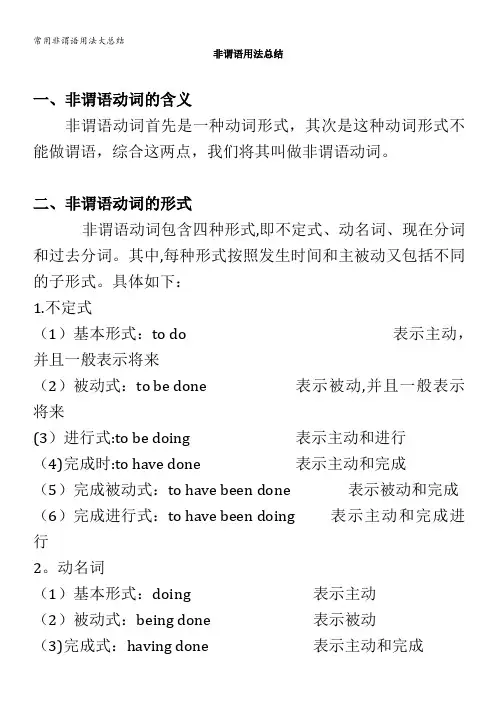
非谓语用法总结一、非谓语动词的含义非谓语动词首先是一种动词形式,其次是这种动词形式不能做谓语,综合这两点,我们将其叫做非谓语动词。
二、非谓语动词的形式非谓语动词包含四种形式,即不定式、动名词、现在分词和过去分词。
其中,每种形式按照发生时间和主被动又包括不同的子形式。
具体如下:1.不定式(1)基本形式:to do 表示主动,并且一般表示将来(2)被动式:to be done 表示被动,并且一般表示将来(3)进行式:to be doing 表示主动和进行(4)完成时:to have done 表示主动和完成(5)完成被动式:to have been done 表示被动和完成(6)完成进行式:to have been doing 表示主动和完成进行2。
动名词(1)基本形式:doing 表示主动(2)被动式:being done 表示被动(3)完成式:having done 表示主动和完成(4)完成被动式:having been done 表示被动和完成3.现在分词(1)基本形式:doing 表示主动和进行(2)被动式:being done 表示被动和进行(3)完成式:having done 表示主动和完成(4)完成被动式:having been done 表示被动和完成4.过去分词(1)done,及物动词的过去分词表示被动或完成;(2)不及物动词的过去分词表示主动或完成三、专题要点非谓语动词和独立主格结构主要用法如下:1。
动名词和动词不定式作主语、宾语;2。
只跟动名词作宾语的动词或动词短语;3.只跟动词不定式作宾语的常见动词;4.既可以跟动名词又可以跟动词不定式作宾语,且意义不同的动词或短语;5。
不定式、现在分词、过去分词作宾语补足语的区别;6。
不定式、现在分词、过去分词作定语时的区别;7。
不定式、现在分词、过去分词作状语时的区别;8。
动名词的复合结构在句中作状语;9.there be 结构的两种非谓语形式;10.独立主格结构在句中作状语;11。

非谓语动词的用法总结动词不定式(一) 时态1. 一般式动词不定式的一般式表示与谓语动词同时或之后的行为。
如: I want to have a restI plan to attend the meeting 2. 完成式不定式的完成式表示不定式的动作发生在谓语动词所表示的动作之前的行为。
如:I ’m sorry to have kept you waiting. 3进展式不定式的动作假如同谓语动词所表示的动作同时发生那么使用不定式的进展式。
如: They seemed to be talking about something important. 4. 完成进展式不定式的完成进展式表示在谓语动词之前已经发生,并且一直进展着的动作。
如: He is said to have been working in that factory for twelve years. 〔二〕动词不定式用法:1. 作主语To master English gives us much help in the study of science 2. 作宾语I want to leave here soon. He pretended to be a doctor. 3. 作表语The most important thing is to study hard. 4. 作宾语补足语不定式作定语必须放在被修饰的名词或代词的后面。
I have no time to talk with her. 6. 作状语不定式作状语时可以表示目的、原因、结果或条件。
I came here to learn from you ( 目的) I ’m very glad to heard the news。
〔原因〕 He is old enough to go to school.(结果) To look at him ,you can’t help laughing.Notes:7. 不定式的复合构造。
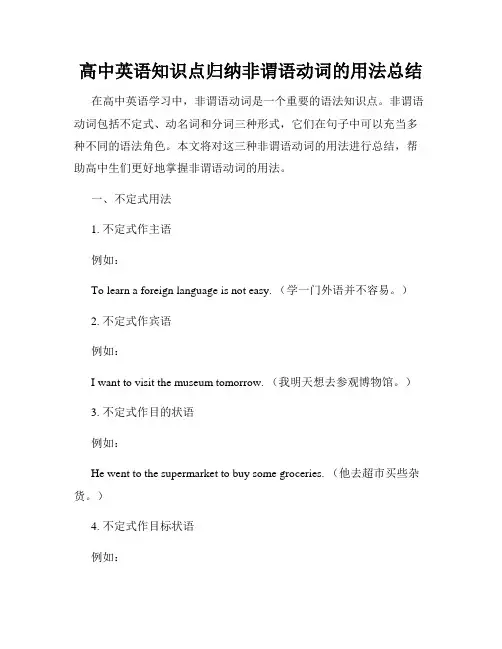
高中英语知识点归纳非谓语动词的用法总结在高中英语学习中,非谓语动词是一个重要的语法知识点。
非谓语动词包括不定式、动名词和分词三种形式,它们在句子中可以充当多种不同的语法角色。
本文将对这三种非谓语动词的用法进行总结,帮助高中生们更好地掌握非谓语动词的用法。
一、不定式用法1. 不定式作主语例如:To learn a foreign language is not easy. (学一门外语并不容易。
)2. 不定式作宾语例如:I want to visit the museum tomorrow. (我明天想去参观博物馆。
)3. 不定式作目的状语例如:He went to the supermarket to buy some groceries. (他去超市买些杂货。
)4. 不定式作目标状语例如:We need to study hard to pass the exam. (为了通过考试,我们需要努力学习。
)5. 不定式作定语例如:The girl to my left is my best friend. (我左边的那个女孩是我最好的朋友。
)二、动名词用法1. 动名词作主语例如:Swimming is my favorite sport. (游泳是我最喜欢的运动。
)2. 动名词作宾语例如:He enjoys playing basketball. (他喜欢打篮球。
)3. 动名词作介词宾语例如:She is good at dancing. (她擅长跳舞。
)4. 动名词作宾语补足语例如:I find it difficult to understand his speech. (我觉得理解他的演讲很困难。
)5. 动名词作定语例如:The running water sounds so relaxing. (流水的声音听起来很放松。
)三、分词用法1. 现在分词作定语例如:The book on the table is mine. (桌子上的那本书是我的。
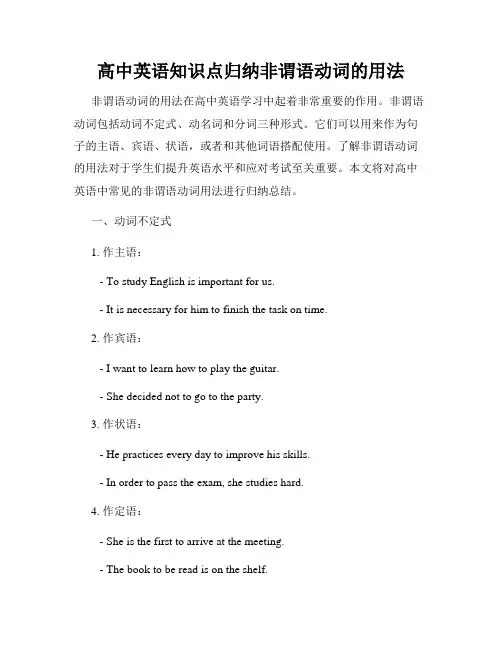
高中英语知识点归纳非谓语动词的用法非谓语动词的用法在高中英语学习中起着非常重要的作用。
非谓语动词包括动词不定式、动名词和分词三种形式。
它们可以用来作为句子的主语、宾语、状语,或者和其他词语搭配使用。
了解非谓语动词的用法对于学生们提升英语水平和应对考试至关重要。
本文将对高中英语中常见的非谓语动词用法进行归纳总结。
一、动词不定式1. 作主语:- To study English is important for us.- It is necessary for him to finish the task on time.2. 作宾语:- I want to learn how to play the guitar.- She decided not to go to the party.3. 作状语:- He practices every day to improve his skills.- In order to pass the exam, she studies hard.4. 作定语:- She is the first to arrive at the meeting.- The book to be read is on the shelf.5. 作表语:- My dream is to become a doctor.- The important thing is to keep calm.6. 作补语:- I need you to help me with the project.- He made her laugh.二、动名词1. 作主语:- Learning a new language requires patience. - Swimming is good for health.2. 作宾语:- I enjoy reading books in my free time.- She admitted stealing the money.3. 作状语:- He left without saying goodbye.- She passed the test by studying hard.4. 作定语:- The running water is very clean.- I heard someone singing in the distance.5. 作表语:- His favorite hobby is playing basketball.- The key to success is hard work.6. 作补语:- I started regretting not studying harder.- They kept us waiting for hours.三、分词1. 现在分词(-ing形式):- The running boy is my brother.- She saw a smoking man on the street.2. 过去分词(-ed/-en形式):- The broken vase needs to be replaced.- They were excited by the surprising news.3. 作状语:- Enjoying the beautiful scenery, we went for a walk.- Being well-prepared, she felt confident in the interview.4. 作定语:- The lost cat was found by its owner.- The written report should be handed in by tomorrow.5. 作补语:- She was surprised to find her car stolen.- I felt exhausted after running for an hour.综上所述,高中英语中的非谓语动词有动词不定式、动名词和分词三种形式,它们在句子中能够充当不同的成分,起到丰富语言表达和提高语言准确性的作用。
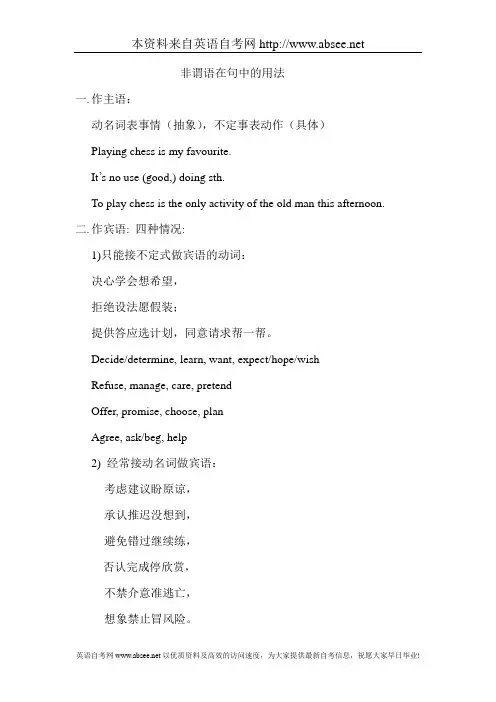
非谓语在句中的用法一.作主语:动名词表事情(抽象),不定事表动作(具体)Playing chess is my favourite.It’s no use (good,) doing sth.To play chess is the only activity of the old man this afternoon.二.作宾语: 四种情况:1)只能接不定式做宾语的动词:决心学会想希望,拒绝设法愿假装;提供答应选计划,同意请求帮一帮。
Decide/determine, learn, want, expect/hope/wishRefuse, manage, care, pretendOffer, promise, choose, planAgree, ask/beg, help2) 经常接动名词做宾语:考虑建议盼原谅,承认推迟没想到,避免错过继续练,否认完成停欣赏,不禁介意准逃亡,想象禁止冒风险。
Consider/suggest/advice, look forward to , excuse/pardenAdmit, delay, fancyAvoid, miss, keep/keep on, pacticeDeny, finish, stop, enjoy/appreciateCan’t help, mind, allow/permit, escape,imagine, forbid, risk在下列词组之后用动名词做宾语:be used to , look forward to , devote to, stick to , object to, get down to , pay attention to, can’t stand , give up, feel like, insist on, put off, thank you for, apologize for, be busy in, have difficulty /trouble in, have good and a wonderful/hard time.3)两者都能接, 意思差异不大:love, like (dislike), hate, start, begin, continue, forgive4) 两者都能接, 意思差异很大:forget, remember, regret, stop, try, mean, go on, can’t help5)习语:a)allow/ advice/ forbid/ permit + doingb)need/ require/ request/ want + doing (to be done)sb. to do sthc)be worth + doingd)be worthy + of being done (to be done)三.非谓语作补语:1.动词只接带to 的不定式作补语:advice, allow, ask, beg, cause, encourage, expect, forbid, force, get, intend, invite, like, love, order, persuade, prefer, require, teach, tell, want, warn, wish, think, wait for, call on, depend on2.下列动词后作补语的不定式不带to, 单变成被动语态时,要还原to.他们是“吾看三室两厅一感觉”5看:look at, see, watch, notice, observe3使:let, have, make2听:listen to, hear1感觉:feel2. 另外,find, catch, keep, leave 常接现在与过去分词作补语。

非谓语知识点总结文库一、非谓语概述非谓语是指不表示谓语的动作、状态或性质,充当主谓宾补成分的动词形式。
非谓语包括动词不定式、动名词和分词。
非谓语可以作状语、定语、宾语、表语等。
二、动词不定式1. 不定式的构成不定式是动词的一种独立形式,由“to + 动词原形”构成。
例如:to go,to play,to sing等。
2. 不定式的用法(1)作主语:To swim is good exercise.(2)作宾语:I want to go shopping.(3)作定语:I have a book to read.(4)作状语:He got up early to catch the first bus.(5)作表语:His duty is to help others.(6)在一些动词后面,如decide, hope, plan, want, agree等,to不定式作宾语补足语。
3. 不定式的否定形式在to后加not,构成否定形式,表示否定的含义。
例如:not to go, not to play。
4. 不定式的完成形式不定式的完成形式表示的动作发生在谓语动作之前。
例如:He hopes to have finished the work by the end of the month.三、动名词1. 动名词的构成动名词是动词的一种特殊形式,由动词原形+ing构成。
例如:swimming,playing,singing等。
2. 动名词的用法(1)作主语:Swimming is good exercise.(2)作宾语:I enjoy swimming.(3)作定语:I have a swimming pool.(4)作状语:She left after finishing her homework.3. 动名词的否定形式在动名词前加not来构成否定形式。
例如:not swimming, not playing。
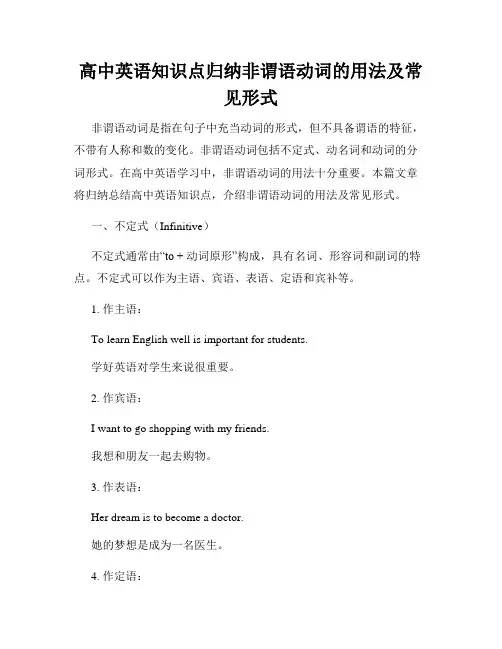
高中英语知识点归纳非谓语动词的用法及常见形式非谓语动词是指在句子中充当动词的形式,但不具备谓语的特征,不带有人称和数的变化。
非谓语动词包括不定式、动名词和动词的分词形式。
在高中英语学习中,非谓语动词的用法十分重要。
本篇文章将归纳总结高中英语知识点,介绍非谓语动词的用法及常见形式。
一、不定式(Infinitive)不定式通常由“to + 动词原形”构成,具有名词、形容词和副词的特点。
不定式可以作为主语、宾语、表语、定语和宾补等。
1. 作主语:To learn English well is important for students.学好英语对学生来说很重要。
2. 作宾语:I want to go shopping with my friends.我想和朋友一起去购物。
3. 作表语:Her dream is to become a doctor.她的梦想是成为一名医生。
4. 作定语:The best way to learn a foreign language is to practice more.学习外语的最好方法就是多练习。
5. 作宾补:She asked me to finish the report as soon as possible.她要求我尽快完成报告。
二、动名词(Gerund)动名词以动词的现在分词形式(-ing)作为主要构词方式,具有名词的特点,可作为名词的任何功能。
1. 作主语:Studying hard is the key to success.努力学习是取得成功的关键。
2. 作宾语:I enjoy singing in the shower.我喜欢在淋浴时唱歌。
3. 作表语:His favorite activity is swimming.他最喜欢的活动是游泳。
4. 作定语:I have a writing class tomorrow.我明天有一节写作课。
5. 作宾补:They felt like going for a walk after dinner.晚饭后他们想去散步。
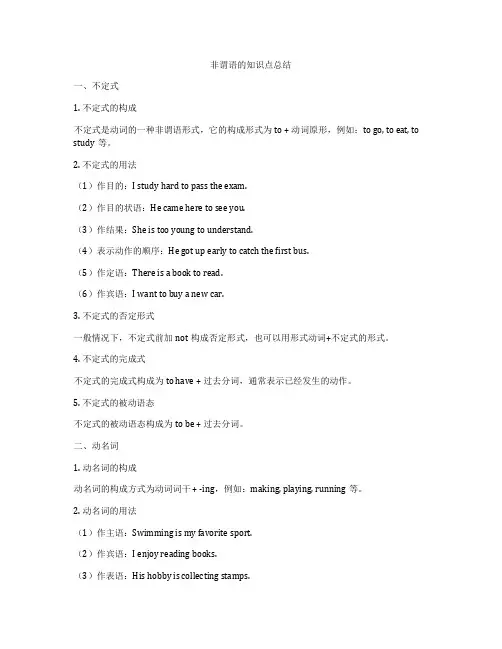
非谓语的知识点总结一、不定式1. 不定式的构成不定式是动词的一种非谓语形式,它的构成形式为to + 动词原形,例如:to go, to eat, to study等。
2. 不定式的用法(1)作目的:I study hard to pass the exam.(2)作目的状语:He came here to see you.(3)作结果:She is too young to understand.(4)表示动作的顺序:He got up early to catch the first bus.(5)作定语:There is a book to read.(6)作宾语:I want to buy a new car.3. 不定式的否定形式一般情况下,不定式前加not构成否定形式,也可以用形式动词+不定式的形式。
4. 不定式的完成式不定式的完成式构成为to have + 过去分词,通常表示已经发生的动作。
5. 不定式的被动语态不定式的被动语态构成为to be + 过去分词。
二、动名词1. 动名词的构成动名词的构成方式为动词词干 + -ing,例如:making, playing, running等。
2. 动名词的用法(1)作主语:Swimming is my favorite sport.(2)作宾语:I enjoy reading books.(3)作表语:His hobby is collecting stamps.(4)作介词宾语:I am tired of waiting.(5)动名词的所有格形式:I remember her reading my letter.3. 动名词的否定形式一般情况下,动名词前加not构成否定形式。
4. 动名词的复合结构动名词能够和其他词语组成复合结构,例如:doing well, running fast等。
5. 句子中的动名词短语动名词短语是指由动名词构成的短语,在句子中起到名词的作用。

非谓语动词的分类及用法总结非谓语动词是指不具备谓语功能的动词形式,包括不定式、动名词和分词。
它们在句中作不同的成分,具有丰富的用法和特点。
本文将对非谓语动词的分类及其用法进行总结。
一、不定式(Infinitive)不定式是动词的一种非限定形式,具有名词、形容词和副词的特点。
不定式一般由动词原形加上“to”构成,也有少数动词不加“to”。
分类:1. 基本不定式:- 例句:I want to go to the movies tonight.(我今晚想去看电影)2. 省略to的不定式:- 例句:Let me help you.(让我来帮你)3. 完全不定式(动词+不定式符号to):- 例句:I want you to listen to me.(我希望你听我说)用法:1.作主语:- 例句:To learn a foreign language requires patience.(学习外语需要耐心)2.作宾语:- 例句:I like to play tennis.(我喜欢打网球)3.作宾语补足语:- 例句:He made her cry. (他使她哭了)4.作定语:- 例句:I have a lot of work to do.(我有很多工作要做)5.作状语:- 例句:He came to borrow some money.(他来借些钱)二、动名词(Gerund)动名词是动词的一种非限定形式,具有名词特点,一般以动词原形加上“-ing”构成。
分类:1. 一般动名词:- 例句:Walking helps keep you healthy.(散步有助于保持健康)2. 所有格形式动名词:- 例句:I appreciate his helping me.(我感激他帮助我)用法:1.作主语:- 例句:Swimming is good for you.(游泳对你有好处)2.作宾语:- 例句:I enjoy reading books.(我喜欢读书)3.作宾语补足语:- 例句:I heard him singing in the shower.(我听见他在洗澡时唱歌)4.作定语:- 例句:She likes playing the piano.(她喜欢弹钢琴)5.作状语:- 例句:He learned English by watching movies.(他通过看电影学英语)三、分词(Participle)分词是动词的一种非限定形式,具有形容词和副词的特点,一般以动词原形加上“-ing”或“-ed”构成。
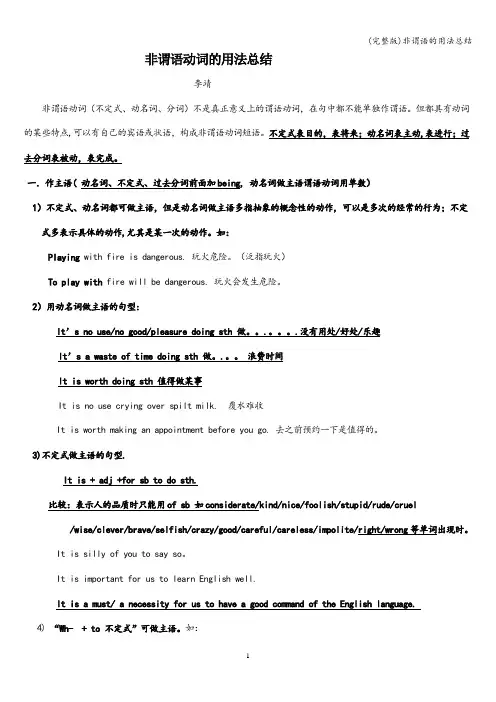
非谓语动词的用法总结李靖非谓语动词(不定式、动名词、分词)不是真正意义上的谓语动词,在句中都不能单独作谓语。
但都具有动词的某些特点,可以有自己的宾语或状语,构成非谓语动词短语。
不定式表目的,表将来;动名词表主动,表进行;过去分词表被动,表完成。
一.作主语( 动名词、不定式、过去分词前面加being, 动名词做主语谓语动词用单数)1)不定式、动名词都可做主语,但是动名词做主语多指抽象的概念性的动作,可以是多次的经常的行为;不定式多表示具体的动作,尤其是某一次的动作。
如:Playing with fire is dangerous. 玩火危险。
(泛指玩火)To play with fire will be dangerous. 玩火会发生危险。
2)用动名词做主语的句型:It’s no use/no good/pleasure doing sth 做。
.。
.没有用处/好处/乐趣It’s a waste of time doing sth 做。
.。
浪费时间It is worth doing sth 值得做某事It is no use crying over spilt milk. 覆水难收It is worth making an appointment before you go. 去之前预约一下是值得的。
3)不定式做主语的句型.It is + adj +for sb to do sth.比较:表示人的品质时只能用of sb 如considerate/kind/nice/foolish/stupid/rude/cruel /wise/clever/brave/selfish/crazy/good/careful/careless/impolite/right/wrong等单词出现时。
It is silly of you to say so。
It is important for us to learn English well.It is a must/ a necessity for us to have a good command of the English language.4) “Wh- + to 不定式”可做主语。

非谓语动词用法总结-标准化文件发布号:(9556-EUATWK-MWUB-WUNN-INNUL-DDQTY-KII非谓语动词用法总结非谓语动词作主语一.动词不定式作主语1.不定式作主语表示具体的动作,通常指一件已知的事或目的。
不定式作主语时,谓语动词用单数。
To say is a thing,to do is another.(说是一回事,做是另外一回事。
)2. 不定式短语较长时,通常放在谓语之后,用it作形式主语。
①It is important to learn English well.(学好英语是重要的。
)②It is necessary for us to do the job well.(我们做好这项工作是必要的。
)③It is a great honor to be invited to give a speech here.(被邀请在这儿发表演讲是一个极大的荣幸。
)二.动词ing不定式作主语1.动名词做主语往往表示经常性、习惯性的动作或状态。
Watching news on TV has become a routine for me.(经常性、习惯性的动作)Talking is easier than doing.(状态)(1)动名词直接置于句首。
Talking is easier than doing.(2).Ving 形式作主语时常后置,用it作形式主语Playing video games is a waste of timeIt is a waste of time playing video games常见句式:It is no good/no use/ useless doing sth 做...没有用的It is a waste of time doing sth做...是浪费时间的(3).There be 结构中作主语:A. There is no+doing 表示不可能做某事There is no knowing the future ==we can’t know the future. 我们不可能知道未来发生什么B.There is no point doing 做某事没有意义There’s no point having wishes if you don’t at least try to do them.拓展:动名词作主语时,单个V-ing 做主语,谓语动词用单数。
非谓语动词的六大用法在句中起名词、形容词或副词的作用,充当句子主语、宾语、表语、宾语补足语、定语和状语而不能起谓语作用的动词,是动词的非谓语形式,又叫作非谓语动词。
非谓语动词有动词不定式(to do)、动词-ing形式和过去分词(done)。
一、动词不定式和动词-ing形式作主语1.不定式作主语表示具体的某次动作,特别是将来动作;动词的-ing形式作主语表示经常性、习惯性动作或已经发生的动作。
To remember these words today is our main task. 今天记住这些单词是我们的主要任务。
Walking is a good form of exercise for both young and old . 散步对年轻人和老年人都是很好的运形式。
Suffering is the most powerful teacher of life.苦难是人生最伟大的老师。
Being laughed at in the public made him angry. 在公共场所被嘲笑使他很生气。
2.不定式和动词的-ing形式作主语的常用句型1) 不定式作主语的句型①It is +形容词(名词) to doIt is better to be safe than sorry. 事后追悔不如事前稳妥。
It is easy to open a shop but hard to keep it always open. 开设店铺易,维持常开难。
It is necessary to complete the design before National Day.在国庆节前完成设计是必要的。
It is very important to follow the rules.遵守规则是非常重要的。
It’s a waste of time to do that. 干那件事是浪费时间。
It is a great art to laugh at your own misfortune. 对己之不幸付之一笑,这是一门伟大的艺术。
非谓语动词的用法总结非谓语动词是英语中的一种特殊动词形式,它可以在句子中作多种不同的成分,包括名词、形容词、副词等。
非谓语动词包括不定式、动名词和分词三种形式,它们在句子中的使用方式和作用各不相同。
下面我们来总结一下非谓语动词的用法。
首先,不定式是非谓语动词中的一种形式,它通常由“to + 动词原形”构成。
不定式可以作主语、宾语、定语、状语等成分。
例如,To learn English well is my goal.(学好英语是我的目标。
)I want to visit Beijing next month.(我想下个月去北京。
)在这两个例句中,不定式分别作主语和宾语。
其次,动名词是非谓语动词中的另一种形式,它是动词+ing形式。
动名词可以作主语、宾语、定语、状语等成分。
例如,Swimming is good for health.(游泳对健康有益。
)I enjoy reading books in my spare time.(我喜欢在空闲时间看书。
)在这两个例句中,动名词分别作主语和宾语。
最后,分词是非谓语动词中的第三种形式,它分为现在分词和过去分词两种形式。
分词可以作定语、状语等成分。
例如,The girl standing there is my sister.(站在那里的女孩是我妹妹。
)He was surprised by the news.(他对这个消息感到吃惊。
)在这两个例句中,分词分别作定语和状语。
总的来说,非谓语动词在句子中的作用多种多样,可以根据具体情况来灵活运用。
在使用非谓语动词时,需要注意与主句的逻辑关系,保持句子结构的平衡和连贯。
希望以上总结对大家在学习和运用非谓语动词时有所帮助。
高中英语非谓语动词用法小结非谓语动词指的是动词的非限定形式,不受主语和谓语的人称和数的限制。
在英语中,非谓语动词主要有不定式、动名词和分词三种形式。
非谓语动词的用法较为灵活,包括作主语、作宾语、作状语等多种用法。
本文将对高中英语非谓语动词的用法进行简要总结。
一、不定式的用法:1. 作主语:动词不定式常常作为句子的主语,可以用it作形式主语,把不定式放在句尾,句子采用完全倒装句的形式,例如:It is dangerous to swim in the river.去河里游泳是危险的。
2. 作宾语:动词不定式常常作为及物动词的宾语,例如:I want to go shopping.我想去购物。
3. 作表语:动词不定式作表语,和主语之间用系动词be连系,例如:Her dream is to become a doctor.她的梦想是成为一名医生。
4. 作状语:动词不定式可以作状语表示目的、原因、结果等,例如:He went to the library to borrow some books.他去图书馆借书。
二、动名词的用法:Reading is my favorite hobby.阅读是我最喜欢的爱好。
His job is teaching English.他的工作是教英语。
1. 现在分词作定语:现在分词常常作为名词前的定语,修饰名词,例如:I saw a girl playing the piano in the park.我在公园里看到一个女孩在弹钢琴。
Seeing the accident, he called the police immediately.看到事故,他立刻报警了。
非谓语动词用法总结大全非谓语动词是历年的热点、难点和重点。
在学习非谓语动词时,好多同学感到"剪不断,理还乱"。
所以在复习中,非常有必要通过观察、比较,归纳掌握其用法,并总结其用法。
下面是店铺整理的非谓语动词用法总结大全,希望对大家的英语学习有所帮助。
最全面的非谓语动词用法总结1 .不定式和动名词作主语的区别(1)动名词作主语通常表示抽象动作;而不定式作主语表示具体动作。
Smoking is prohibited(禁止)here.这里禁止抽烟。
(抽象)It is not very good for you to smoke so much.你抽这么多烟对你身体很不好。
(具体)(2)动名词作主语时,通常用以表示一件已知的事或经验。
不定式短语通常用来表示一件未完成的事或目的。
Climbing mountains is interesting.爬山很有趣。
(经验)Driving a car during the rush hour is tiring.在高峰时刻开车令人厌烦。
(经验)(3)不定式做主语,一般用it当形式主语,把作主语的不定式短语后置。
It took me only five minutes to finish the job.2 .不定式、动名词和分词作表语的区别(1)不定式作表语1)不定式作表语一般表示具体动作,特别是表示将来的动作。
To do two things at a time is to do neither.--次做两件事等于未做。
What I would suggest is to start work at once.我的建议是立刻开始干。
2)如果主语是不定式(表示条件),表语也是不定式(表示结果)。
To see is to believe.百闻不如一见。
To work means to earn a living.工作就是为了生活。
3)如果主语是以aim,duty,hope,idea,happiness,job,plan,problem,purpose,thing,wish等为中心的名词,或以what引导的名词性从句,不定式作表语是对主语起补充说明作用。
高中英语知识点归纳非谓语动词的用法和种类高中英语知识点归纳:非谓语动词的用法和种类在英语语法中,动词是句子的重要组成部分。
除了常见的谓语动词外,还存在一种特殊的形式,即非谓语动词。
非谓语动词是指在句子中不作谓语的动词形式。
本文将对非谓语动词的用法和种类进行归纳总结。
一、不定式(Infinitive)不定式是非谓语动词中最常见的形式之一。
它的结构为“to + 动词原形”。
不定式可以用作主语、宾语、定语、表语以及宾语补足语等。
1. 作主语:To learn English well takes time and effort.(学好英语需要时间和努力。
)2. 作宾语:She wants to visit her grandparents this summer.(她想要这个夏天去拜访她的祖父母。
)3. 作定语:The best way to learn a new language is to practice regularly.(学习一门新语言的最好方法是定期练习。
)4. 作表语:Her dream is to become a successful writer.(她的梦想是成为一名成功的作家。
)5. 作宾语补足语:I find it difficult to understand this article.(我发现这篇文章很难理解。
)二、动名词(Gerund)动名词是非谓语动词的另一种形式,它的形式为动词的-ing形式。
动名词可以用作主语、宾语、定语以及表语等。
1. 作主语:Swimming is his favorite sport.(游泳是他最喜欢的运动。
)2. 作宾语:I enjoy reading novels in my free time.(我喜欢在闲暇时间读小说。
)3. 作定语:The smiling girl in the picture is my sister.(照片中微笑的女孩是我的姐姐。
常用非谓语用法大总结非谓语用法是指动词的非谓语形式(不带主语和谓语),包括不定式、动名词和现在分词、过去分词。
非谓语在句子中具有特定的功能和作用,可以作主语、宾语、状语等,能够丰富句子结构,增强表达的灵活性。
以下是常用的非谓语用法大总结:一、不定式用法:1.作主语:To love is to live.(爱即是生活。
)To err is human, to forgive divine.(人非圣贤,孰能无过。
)2.作宾语:I hope to see you.(我希望见到你。
)He wants to go shopping.(他想去购物。
)3.作表语:4.作宾补:They agreed to help us.(他们同意帮助我们。
)I want to eat some fruit.(我想吃些水果。
)5.作定语:I have a book to read.(我有一本书要读。
)This is the place to be.(这是最佳位置。
)6.作状语:She went to the store to buy some milk.(她去商店买牛奶。
)7.动词不定式的形式和功能:主动形式:to +动词原形被动形式:to be +过去分词8.一些常见的固定搭配:to be honest(老实说), to be frank(坦白说), to be fair (公平地说), to be sure(确切地说), to tell the truth(实话告诉你), etc.二、动名词用法:1.作主语:Smoking is harmful to health.(吸烟对健康有害。
)Learning is a lifelong process.(学习是一辈子的事。
)2.作宾语:I enjoy swimming.(我喜欢游泳。
)She suggested watching a movie.(她建议看电影。
)3.作表语:His hobby is playing basketball.(他的爱好是打篮球。
精品文档你我共享非谓语动词的用法总结李靖非谓语动词(不定式、动名词、分词)不是真正意义上的谓语动词,在句中都不能单独作谓语。
但都具有动词的某些特点,可以有自己的宾语或状语,构成非谓语动词短语。
不定式表目的,表将来;动名词表主动,表进行;过去分词表被动,表完成。
一•作主语(动名词、不定式、过去分词前面加being,动名词做主语谓语动词用单数)1)不定式、动名词都可做主语,但是动名词做主语多指抽象的概念性的动作,可以是多次的经常的行为;不定式多表示具体的动作,尤其是某一次的动作。
如:Playing with fire is dan gerous.玩火危险。
(泛指玩火)To play with fire will be dangerous玩火会发生危险。
2)用动名词做主语的句型:It ' s no use/no /pdeidsure doing sth故没有用处/好处/乐趣It ' s a waste of time doing做th 7良费时间It is worth doing sth值得做某事It is no use crying over spilt milk.覆水难收It is worth making an appo in tme nt before you g去之前预约一下是值得的。
3)不定式做主语的句型.It is + adj +for sb to do sth.比较:表示人的品质时只能用of sb 如 considerate/kind/nice/foolish/stupid/rude/cruel /wise/clever/brave/selfish/crazy/good/careful/careless/impolite/right/wio单词出现时。
It is silly of you to say so.It is importa nt for us to lear n En glish well.It is a must/ a necessity for us to have a good command of the English language.4)“Wh- + to不定式”可做主语。
女口:When to leave hasr i t been decided ye什么时候动身还没定呢。
Whether to drive or take the train s still a problem是自驾车还是乘火车仍是一个问题。
5)一般情况下,不定式和动名词作主语,谓语动词一般用单数形式。
如:Seeing is believi ng.= To see is to belieVI 见为实。
Plan ti ng flowers n eeds con sta nt wateri ng.但and连接的多个动名词作主语,谓语动词大多用复数(如果前后动名词的语义一致,谓语一般用单数)。
如:Lying and stealing are immoral说谎与盗窃是不道德的。
6)动名词前面可以加上形容词性物主代词构成动名词的复合结构。
女口:——What made him an gry?----- M ary' s /My/His/He/Their/ The boy ' s/ The president '(marteitgriateigry.7)过去分词不能单独做主语,前面必须加上being构成动名词,做主语。
如:Being_exposed_to_the_s|uni harmful to the skinBeing examined twice a yea whether it is a car, a bus orthe rule that every driver must obey in this city经典练习:1. It' s important for the figures ________ (update) regularly.2. No matter how bright a talker you are, there are times whensitbetter _____ (rema in)sile nt.3. It' s really stupid of you _______ (tell) him the news yesterday so it has been disturbinghim all the time.4. _________ (un dersta nd)your own n eeds and styles of com muni cati on is as importa nt aslear ning to convey your affect ion and emoti ons.5. _________ (worry) about your grades dodsn help.6. The engine just wont start. Someth ing seems ____ (go) wrong with it.参考答案:1. to update 2. to remain 3. to have told 4. understanding 5. worrying 6.to go 改错题:一个句子最多有一处错误1. It's standard practice for a company like this one employ a security officer.2. Hear how others react to the book you have just read creates an added pleasure.3. Know basic first-aid tech niq ues will help you resp ond quickly to emerge ncies.4. Do well in an in terview will be an importa nt part of gett ing a place at uni versity.5. He told us whether have a pic nic was still un der discussi on.6. How prevent them from swimming in this river is a problem.参考答案:1.在employ 前加to 2. Hear 改为Hearing 3. Know 改为Knowing4. Do 改为Doi ng5. have 前加to6. preve nt 前加to.二作定语1) 作定语的不定式如果是不及物动词,或者不定式所修饰的名词或代词是不定式动作的地点、工具等,不定式后面需要有相应的介词,如:The Brow ns have a comfortable hous e live in2) 用不定式作定语的几种情况:a. 不定式表将来如:The car to be bought is for his sister.b. 用来修饰被序数词、最高级或no, all, any the only等限定的中心词,且与中心词为逻辑上的主动关系,女口:He was the best mar to do the job.She was the first woman to win the gold medal in the Olympic Games.c. 有些名词的同根词常跟不定式,因而它们也常跟不定式做定语,常见的有:promise, plan,attempt, offer, decision, refusal, failure, ability, chance, warning, anxiety, eagerness, willingness, readineS SI don' t trust his promise to come for a visit.He said he had no pla n to go there.He made an attempt to sta nd up.Birds' singing is sometimes a warning to other birds to stay away.3) 前置定语:V+ing可以表示正在进行,也可以表示特征;过去分词表示已经完成或状态请区别下面短语:the boili ng/ boiled water.正沸腾的水(表正在进行)/白开水(表完成)a good-look ing flower. 一朵好看的花儿(表特征)the develop ing coun tries/ the developed coun trie发展中国家/发达国家the falli ng leaves / the falle n leave正在下落的叶子/ 落叶the remaining mon ey/ the money le剩下的钱注意:英语中有些表示感觉的动词,其现在分词形式表示“令人感到…..的”,过去分词形式表示“感到….的”如:an excit ing voice 一个令人兴奋的声音an excited voice 一个兴奋的声音a puzzling expression —个令人困惑的表情 a puzzled expression一个困惑的表情4) 区别下列后置定语的用法:厂to be done表示被动、将来;done表示被动、完成;彳being done表示被动、正在进行;v+ing表示主动;'动词的系表结构直接去掉动词be;如果是不及物动词或者是感官系动词sound/taste/ feel/ smell/ loo和变化系动词就只有用V+ing形式。
Have you read the nove W ritten by Dicke ns?Liste n! The son g being sung s very popular with stude nts.The questior to be discussed tomorrow" s meeting is a very important one.The food tasting deliciou sells well.注意:不定式在后置定语中只表示将来,不表目的;having dong或者having been done^般用在状语中,不可以做后置定语,过去分词本身就表被动和完成。